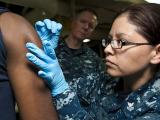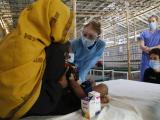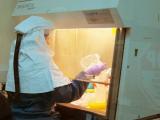Sep 11, 2002 (CIDRAP News) The Department of Defense's (DoD's) vaccine acquisition program is poorly organized and underfunded, making it difficult for the department to obtain important vaccines and maintain the supply of existing ones, according to a new report from the Institute of Medicine (IOM).
"Such an inefficient acquisition process puts military readiness at risk," the report states. "Some militarily important vaccines are not available, in whole or in part, because of poorly aligned acquisition processes and an inadequate commitment of financial resources rather than uncleared scientific or technological hurdles."
The report cites adenovirus and anthrax vaccines as prime examples of the problems. Because of cost increases related to regulatory difficulties, manufacture of an effective vaccine for adenovirus serotypes 4 and 7 stopped in 1996; the vaccine supply ran out in 1999, resulting in higher respiratory illness rates among recruits, the report says. In 1998, DoD launched a program to vaccinate all military personnel against anthrax, but the effort had to be sharply curtailed in 2000 because of a vaccine shortage resulting from the manufacturer's difficulty in meeting Food and Drug Administration (FDA) requirements.
The IOM report, called "Protecting our Forces: Improving Vaccine Acquisition and Availability in the US Military," was prepared by a 14-member committee chaired by Stanley M. Lemon, MD, dean of medicine at the University of Texas Medical Branch in Galveston.
DoD currently uses 17 vaccines for its personnel, the report says. It notes that vaccines are important for the military because recruits train in crowded conditions that favor the spread of disease. In addition, soldiers in the field are exposed to pathogens that are new to them and face a growing risk of exposure to biological weapons as well.
The committee contends that DoD's problems with vaccines are to a large extent related to a failure to understand for the complexity of the vaccine business. "The current DoD vaccine acquisition process does not take sufficient account of the fact that vaccines are complex systems and not simply commodities that can be specified, procured, and placed on the shelf for future use," the report says.
To help correct this, the committee recommends that DoD have a single authority to oversee all the steps in vaccine development and procurement. The department now has two separate authorities: the US Army Medical Research and Materiel Command, for vaccines for naturally occurring diseases, and the Joint Vaccine Acquisition Program, for vaccines against biological weapons. Because many pathogens that may be used in weapons also occur naturally, this setup causes duplication and makes little sense, the committee contends. It says the vaccine authority should have a permanent advisory group with members from inside and outside DoD.
Because vaccines are very costly to develop and produce, and other products may offer higher returns, "DoD needs to create stable incentives and contractual obligations for manufacturers to remain motivated and capable of producing vaccines over the long term," the report states. Recent shortages of vaccines used routinely in the general population have demonstrated the "fragility" of the vaccine supply. The committee recommends several options that could help DoD keep vaccines in production: strengthen and expand its partnerships with individual manufacturers; promote the development of a consortium of manufacturers; and build a government-owned, contractor-operated manufacturing plant.
Further, the report urges DoD to work with the FDA on a new regulatory approach that recognizes the special status of vaccines used only or primarily by the military. "Special-use" vaccines are as difficult and costly to develop as widely used vaccines but are less profitable, the report says. Accordingly, DoD should "vigorously seek a new paradigm for the regulation of special-use vaccines that remain in Investigational New Drug status with the Food and Drug Administration without reasonable prospects of licensure under current rules, ensuring demonstration of the safety and efficacy of these products commensurate with their anticipated use."
See also:
IOM report (table of contents page )
http://books.nap.edu/books/0309084997/html/index.html


















